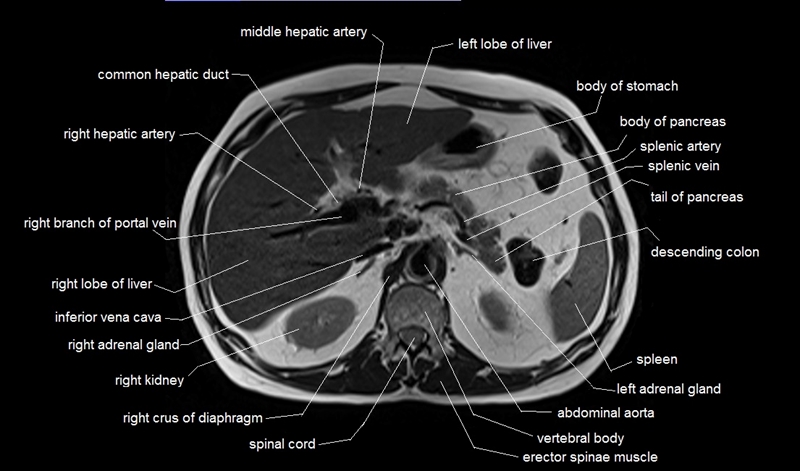What is an Abdominal MRI?
Magnetic resonance imaging (MRI) of the abdomen is a painless, noninvasive test that produces detailed images of your abdomen and all of the internal structures within. An MRI machine creates the images using a magnetic field and radio waves. We utilize breath holds to prevent motion on scans of the abdomen. Breath holds can last from 10-20 seconds at a time.
An MRI scan combines images to create a 3-D picture of your internal structures, which allows for optimal visualization of internal structures within the abdomen, such as the liver; gallbladder; kidneys; pancreas; adrenal glands; stomach and intestines. You can also clearly see internal linings and vessels. Sometimes a contrast agent, or dye, can be given through an intravenous (IV) line to better visualize certain structures or abnormalities.
An (MRCP) Magnetic Resonance Cholangiopancreatograhy can also be done. This is an MRI technique used to look at the biliary and pancreatic ducts. This is useful in determining if gallstones are lodged in the ducts.
Why do I need an Abdominal MRI?
An abdominal MRI is a useful tool for detecting a number of conditions, including:
- Cancer, tumors, cysts and/or masses.
- Blood flow in the abdomen
- Blood vessels in the abdomen
- The cause of abdominal pain or swelling
- The cause of abnormal blood test results, such as liver or kidney problems
- Lymph nodes in the abdomen
- Visualization of gallbladder, biliary and pancreatic ducts
Your doctor may also order an abdominal MRI to investigate symptoms such as:
- Abdomen pain
- Nausea and/or vomiting
- Diarrhea/ Constipation
- Blood in stool
- Loss of appetite
- Uncontrolled Hypertension
Additionally, there is a type of MRI called magnetic resonance angiography (MRA), which better examines the blood vessels in the abdomen.
How do I prepare for an Abdominal MRI?
You will need to be NPO (nothing to eat/drink for at least 6 hours) for this test.
The medical staff will need to know if you have any metal in your body, including:
- inner ear implants
- artificial joints
- a defibrillator or pacemaker
- particular types of heart valves
- vascular stents
- brain aneurysm clips
- metal shrapnel
- bullets
- piercings
- pain pumps
- diabetic pumps
If you’re wearing anything that contains metal, including jewelry or sunglasses, you will need to remove those items. Metal interferes with the MRI machine’s ability to produce a clear image. Braces and dental fillings typically won’t pose a problem, but pocketknives, pens, pins, and certain dental appliances can interfere. The staff may ask you to wear a hospital gown or clothing that doesn’t contain metal fasteners. You can’t have electronic devices in the MRI room.
Tell the medical staff if you’re pregnant. An MRI’s magnetic field affects unborn children in a way that isn’t yet fully understood.
Additionally, it’s important to let the staff know if you are claustrophobic. If so, you might need to take sedatives during the exam or have an “open” MRI. Open MRI machines have wider tunnels, which tend to be more tolerable for claustrophobic patients.
How is an MRI performed?
During the exam, you will lie down on the MRI table. A coil may be placed around your abdomen to bring more signal to the area of interest. The table will slide into the bore (tunnel) of the machine. It is very important to hold still throughout the test so there is no motion artifact on the exam. Because of this, you will be given headphones so the tech can instruct you when to hold your breath and when to let your breath out. Each breath hold can last from 10-20 seconds.
The test normally takes 30 to 60 minutes. You may receive a contrast solution, usually gadolinium, through an IV to allow the MRI machine to see certain parts of your abdomen more easily. The MRI scanner will make loud banging noises during the procedure.
There are no risks associated with an MRI itself. There is a very slight chance that you will have an allergic reaction to a contrast solution. Tell the medical staff if you have decreased kidney function. It may not be safe to use contrast solution if this is the case.
Breastfeeding
Women shouldn’t breastfeed 24 to 48 hours after they’ve been given contrast dye. They need to wait for the dye to leave their bodies.
What happens after an abdominal MRI?
After the test, you can get dressed and leave the testing facility. If you were sedated for the exam you will need to have someone with you, usually a friend or relative, to drive you afterwards.
A radiologist will analyze your MRI images and provide your doctor with the results. Next steps will depend on whether the results revealed anything unusual or discovered the cause of any abnormalities.





